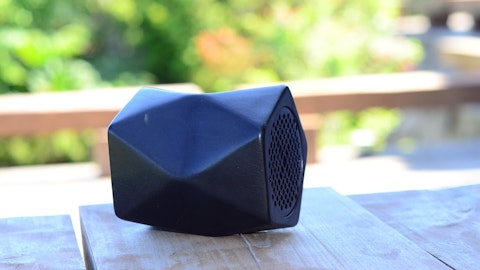Dolby Laboratories, Inc. (NYSE:DLB) Q1 2024 Earnings Call Transcript February 1, 2024
Dolby Laboratories, Inc. isn’t one of the 30 most popular stocks among hedge funds at the end of the third quarter (see the details here).
Operator: Ladies and gentlemen, thank you for standing by. Welcome to the Dolby Laboratories Conference Call discussing Fiscal First Quarter Results. [Operator Instructions] As a reminder, this call is being recorded, Thursday, February 1, 2024. I would now like to turn the conference over to Mr. Peter Goldmacher, Vice President of Investor Relations. Peter, please go ahead.
Peter Goldmacher: Good afternoon. Welcome to Dolby Laboratories first quarter 2024 earnings conference call. Joining me today are Kevin Yeaman, Dolby Labs CEO; and Robert Park, our CFO. As a reminder, today’s discussion will include forward-looking statements, including our fiscal 2024, second quarter and full year outlook and our assumptions underlying that outlook. These statements are subject to risks and uncertainties that may cause actual results to differ materially from the statements made today, including, among other things, the impact of current macroeconomic events, ongoing supply chain issues inflation rates, changes in consumer spending and geopolitical instability on our business. A discussion of these and additional risks and uncertainties can be found in the earnings press release that we issued today under the section captioned forward-looking statements as well as in the Risk Factors section of our most recent report on Form 10-Q.
Dolby assumes no obligation and does not intend to update any forward-looking statements made during this call as a result of new information or future events. During today’s call, we will discuss non-GAAP financial measures. A reconciliation between GAAP and non-GAAP financial measures is available in our earnings press release and in the Interactive Analyst Center on the Investor Relations section of our website. With that, I’d like to turn the call over to Kevin.
Kevin Yeaman: Thank you, Peter and thanks to everyone for joining us today. Revenue for the quarter came in about where we expected and earnings were better than we expected. Our guidance for the full year is unchanged and Robert will share detailed guidance for the second quarter in a few minutes. Today, I’d like to cover 3 topics. First, I’d like to make some brief comments on the macro environment. Second, I’d like to talk about our business and the momentum we are seeing in Dolby Atmos and Dolby Vision. And third, I’ll wrap up my portion of the call with some brief closing thoughts. So first on the macro, not much has changed. Spending on consumer electronics is the largest factor impacting our foundational offerings. We aren’t seeing anything that would cause us to change our FY ’24 guidance for mid-single-digit declines in foundational licensing revenue.
As it relates to Dolby Atmos and Dolby Vision, we continue to have strong engagement across creators, distributors and device manufacturers and we remain comfortable with our full year guidance for high single-digit growth for Dolby Atmos and Dolby Vision. Over time, we continue to expect foundational to return to low single-digit growth and Dolby Atmos and Dolby Vision and imaging patents to grow at a 3- to 5-year CAGR of between 15% and 25%. So let me turn to the business. Today, I will focus on Dolby Atmos and Dolby Vision which are the biggest components of our growth opportunity in the midterm and an important part of the path to returning the company to double-digit growth over time. We look at the opportunity with Dolby Atmos and Dolby Vision, primarily through the lens of market ecosystems which is the intersection of device, distribution and content.
Our primary focus for new wins in automotive is with Dolby Atmos Music. For TV, it is TV shows, including sports and movies. And for mobile, it is videos via user-generated content. In each ecosystem we serve, we focus on enabling great content which gives us the opportunity to grow our OEM partnerships. The real value of an OEM partnership is realized over years and decades as our partners adopt more of our technology and put our technology on more of their devices. I share this perspective with you to help you understand why we remain so excited about ongoing momentum in the creative community and confident and optimistic about the long-term opportunity for our business. If you recall, last quarter, we described the virtuous cycle of Dolby Atmos and Dolby Vision.
We work with creators and distributors to create high-quality content in Dolby. So that when consumers buy Dolby-enabled devices, they enjoy a more engaging and immersive audio and visual experience. The virtuous cycle for Dolby is as more devices support the Dolby experience, the more content creators want to create in Dolby and the more distributors want to deliver that content. On the creator and distributor side of the cycle, we continue to see very strong adoption of Dolby Atmos and Dolby Vision. Artists continue to leverage Dolby for their best work. We are in the midst of award season and the breadth of Dolby adoption and momentum is clear through this lens. Every nominee for Record, Album, Song and New Artist of the Year for the 2024 Grammy’s used Dolby Atmos.
92% of the Billboard 2023 year-end top 100 artists are available in Dolby Atmos. And over 100 shows in Dolby Technologies were nominated across the Emmys and the Oscars including Emmy Winners; Succession and The last of Us. We continue to increase the availability of Dolby content through distribution partners, including Z5, an Indian OTT service for the 120 million monthly active users which announced Dolby Vision support on its platform shortly after adding support for Dolby Atmos earlier in 2023. These highlights reinforce the momentum Dolby Atmos and Dolby Vision have in the artists and streaming communities in their quest to deliver the best audiovisual experience as possible. We are focused on making these experiences available on as many devices as possible.
We just returned from CES, where Dolby Atmos and Dolby Vision were on full display across the show floor, particularly in the living room in devices like TVs and soundbars. And we continue to be featured in lineup announcements from our partners, including TCL, LG and Hisense. We also have strong engagement with Dolby Atmos FlexConnect, our new living room solution that enables consumers to place wireless speakers paired with a TV anywhere in a room and automatically get an immersive Dolby Atmos experience. Hisense announced that they would begin supporting Dolby Atmos FlexConnect on their TVs. In gaming, Alienware and ASUS, two of the world’s leading gaming monitor manufacturers announced support for Dolby Vision. A big focus of the show for us was our growing presence in auto.

We enjoyed positive reactions from our Dolby Atmos-enabled demo car which delivers a fully immersive Dolby Atmos experience in an affordable midsized car with a standard 4-channel, 8 speaker sound system. In addition, Apple recently announced support for Dolby Atmos in CarPlay. Broadening our market opportunity by enabling auto OEMs to offer consumers multiple ways to experience Dolby Atmos in their cars. On the OEM side, as of the end of the first quarter, we’ve announced agreements with 13 auto OEMs, up from 10 at the end of the fourth quarter. One of our new partners this quarter is Zeekr, the premium EV brand of Chinese automaker Geely. They announced that the Zeekr 007 which is expected to retail for less than $30,000 will support Dolby Atmos and they are going to be doing that via an over-the-air update later this year.
Interestingly, about half of our OEM partnerships are with Chinese EV manufacturers which are quickly becoming some of the most popular cars on the road in China and Europe. We’re also excited that the Apple Vision Pro which begins shipping tomorrow will include Dolby Atmos and Dolby Vision. We believe Apple’s spatial computing environment with Dolby Atmos and Dolby Vision will continue to expand the horizons of what is possible with sight and sound. To sum up on Dolby Atmos and Dolby Vision, we continue to make progress on multiple fronts. This progress gives us confidence in our expectation for a multiyear CAGR of 15% to 25% for Dolby Atmos, Dolby Vision and imaging patents. Looking beyond Dolby Atmos and Dolby Vision. We’ve talked to you about our opportunity with Dolby.io, where we are focused on enabling more engaging real-time and personalized experiences in sports and entertainment.
We are seeing strong demand for our ultra-low latency real-time streaming product. And while it’s early days, we just closed our first 7-figure deals. I’d like to wrap up my comments with some closing thoughts. It was a solid quarter and our outlook for the year is unchanged. Looking forward, our foundational offerings remain strong and we have momentum with Dolby Atmos and Dolby Vision. We continue to invest in innovation and attractive new areas of growth, including Dolby.io and we have a strong margin profile with healthy cash generation. All of this gives us confidence in our opportunity to grow revenue and earnings going forward. And with that, I’ll turn it over to Robert.
Robert Park: Thanks, Kevin. Before we get to the detailed financials, I’d like to share 3 thoughts. First, revenue for Q1 was within the range we laid out in the Q4 earnings call and profitability came in higher than guidance, primarily due to timing of spend. Second, while the environment remains uncertain, our guidance for the full year remains unchanged. And third, as I’ve said before, we feel good about our long-term prospects as our value proposition remains strong and our financials are solid. Q1 revenue was $316 million, down 6% compared to the year ago quarter and just above the midpoint of guidance we shared with you on the last earnings call. Licensing revenue of $294 million was down 5% year-over-year. Products and services revenue was $22 million, down 19% year-over-year, driven by lower cinema product sales and came in lower than expected due to timing of orders now expected later in the year.
Detailed licensing performance by end market is on our IR website but I’d like to point out some noteworthy details. As a reminder, timing of recoveries, minimum volume commitments and true-ups can drive volatility between quarters. And we saw that dynamic in mobile this quarter as we expected. In Q1, mobile revenue was down about 45% year-over-year due to these factors but we still expect mobile to be down only slightly for the full year. Our end market outlook for the full year is unchanged from last quarter’s call. We continue to expect solid growth in other markets and PC should benefit from slightly higher units, higher revenue in imaging patents and recoveries. This increase will be offset by slight declines in broadcast, CE and mobile.
While we see growth in Dolby Atmos and Dolby Vision in these markets this year, the overall revenue declines are primarily due to tough comps in terms of timing and size of deals and true-ups in foundational and imaging patents. Moving to the bottom line; in Q1 we earned $1.01 per diluted share on a non-GAAP basis, above the high end of our guidance, primarily due to lower operating expenses related to timing of patent program spend, higher other income and lower taxes. We generated $8 million in operating cash flow. As a reminder, over time, operating cash flow will correlate to non-GAAP net income but this quarter, we had a variety of timing issues working against us. Moving on; we repurchased $8 million of common stock and have $132 million remaining on our repurchase plan authorization.
We declared a $0.30 dividend, up 11% from our dividend a year ago and ended the quarter with cash and investments of just under $900 million. We recorded a $6 million non-GAAP restructuring charge in the quarter, in line with the restructuring plan we communicated last quarter and completed in November. Turning to guidance; there is still uncertainty in the market and our guidance assumes no material change in the macroeconomic environment. While we continue to see steady growth of content created and distributed in Dolby technology and strong engagement from our partners, device shipments remain soft and things are just taking longer to get done. For Q2 ’24, we expect revenue to be between $345 million and $375 million. Within that, licensing revenue is estimated to range from $320 million to $350 million.
Gross margin should be approximately 90% on a non-GAAP basis. We expect non-GAAP operating expenses to be between $180 million and $190 million. Our effective tax rate for Q2 is projected to be around 20% on a non-GAAP basis. So as a result, we estimate that non-GAAP EPS should be between $1.14 and $1.29 per diluted share. Our full year guidance for fiscal year ’24 is unchanged at roughly flat revenue. Embedded in this guidance is an assumption of a mid-single-digit decline in foundational audio licensing revenue offset by high single-digit growth in Dolby Atmos, Dolby Vision and imaging patent licensing revenue and flat product and services revenue. Non-GAAP gross margin should be roughly 89%. Non-GAAP operating expenses for the full year should be in the $740 million to $750 million range which will result in about a 1 to 2 percentage point improvement in operating margins on a full year basis.
On the bottom line, we are expecting non-GAAP EPS between $3.60 and $3.75 per diluted share. To wrap things up, the creation and distribution of Dolby-enabled content continues to grow nicely. Our partners are still very engaged. Our financials remain strong and we are well positioned for growth when economic conditions improve. With that, I’d like to turn it back to the operator to open the line for your questions. Operator?
See also Retiring Abroad: Top 20 Places Boomers Prefer to Retire Outside the US and 30 Most Air Polluted Cities In The World.
Q&A Session
Follow Dolby Laboratories Inc. (NYSE:DLB)
Follow Dolby Laboratories Inc. (NYSE:DLB)
Operator: [Operator Instructions] Your first question comes from the line of Ralph Schackart with William Blair.
Ralph Schackart: Kevin, maybe kind of go back to some of your introductory comments on macro. I think you talked about some of the macro being the same as last call but maybe just kind of taking a step back as you look out into 2024 this year and if you compare where you are today versus if you looked out into 2023. Maybe just sort of give an assessment of the relative macro, I guess, this year versus last year when you were looking out.
Kevin Yeaman: Yes. Thanks for the question, Ralph. So of course, as it relates to our foundational revenues, the biggest macro factor is the number of device shipments. And as we said, we haven’t seen anything that would cause us to change our outlook for that. As it relates to kind of the overall environment which you’re referring to, I would remind you that what — we didn’t say that we saw a couple of big deals delays. What we did see was that it’s been a couple of years of an uncertain and changing kind of economic environment. And a lot of companies are devoting attention cycles to making their adjustments to focus on that. And that just has had an effect overall of — some deals could take another month or two to get that device win.
It could take another month or two for a partner to get from a device win to a product in market or sometimes they have their product ready to go and they might, for a number of reasons, decide to launch it a few months later. So all of that was the dynamic we talked about that we were seeing the cumulative effect of last quarter when we guided to high single-digit growth in Dolby Atmos and Dolby Vision and imaging patents. And we are still growing; we still see growth of high single digits. We continue to have really strong engagement across the ecosystem. We continue to see high single-digit growth for the year. And we continue to be confident that with the engagement we have and the wins that we’re getting that we can return to the 15% to 25% CAGR over that midterm 3- to 5-year period.
Ralph Schackart: Great. And then maybe just kind of circling back a little bit to CES, you had some comments in the prepared remarks. So maybe just give an assessment of how CES went this year perhaps versus last year? Any momentum you’re seeing at least perhaps with like initial conversations coming out of this year?
Kevin Yeaman: Yes. So I think one highlight for us was just that as you walk the show floor Dolby is everywhere across the show floor. And we were featured in a number of our partners’ lineup announcements. We were featured across the living room — across all living room devices. So that was a real highlight sort of outside of the Dolby space around everywhere. Within the Dolby space, of course, we were showing everything we do but I would say automotive is where we just had a lot of engagement, a lot of activity. We had a lot to share. We had a demo car which really shows the full power of the Dolby Atmos experience for a car at an affordable price point with 4 channels and 8 speakers, a lot of interest in that. We had in a number of cars, it’s nothing like actually experiencing Dolby Atmos to get excited about Dolby Atmos in the car.
And we have a really robust pipeline, really strong engagement, almost every major auto manufacturer is represented at the show and we had a lot of people coming through. So those were some of the highlights for us, Ralph.
Ralph Schackart: Great. Maybe one last one and I’ll turn it over. And historically, Dolby has been sort of a professional consumer strategy. And a lot of times, your newer products start pretty high in devices and make their way into more mass market prices. Anything you’re observing in the auto market that would sort of suggest that, that would alter. Things maybe perhaps picking up where you might see Atmos move to your less expensive vehicles. Just would love your thoughts on that.
Kevin Yeaman: Yes, it’s a great question because, as you know, that is — our goal is to have Dolby Atmos be the way everybody experiences music in the car. And it’s early days. We’re at 13 OEM wins. That’s up from 10 last quarter. We’ve only been at it a couple of years. Just over half of those are shipping in the market; many of them will be coming to market this year. We’ve already seen partners like Mercedes extend to — they’re already up to 10 models. And we expect to release more this year. This quarter, I mentioned Zeekr by Geely in China, that model they announced is going to be at a price point of just under $30,000. So I do believe that there is something about the Dolby Atmos experience, the importance of music in the car which combined with the engagements we’re having that we believe we have the opportunity to get to the mainstream even as we started out at the high end here.





